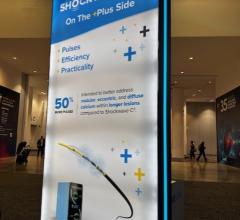
October 18, 2020 – The first results from the IN.PACT Below the Knee (BTK) Study, a feasibility study assessing the safety and effectiveness of the Medtronic IN.PACT 0.014 drug-coated balloon (DCB) in critical limb ischemia (CLI) subjects with chronic total occlusion (CTO) in the infrapopliteal arteries. The data were presented in the Late-Breaking Clinical Trial Sessions at 2020 Transcatheter Cardiovascular Therapeutics (TCT) Connect virtual symposium of the Cardiovascular Research Foundation (CRF).
“The design of this feasibility study is incredibly thorough, and required rigorous procedural, duplex ultrasound, and angiographic protocols to more accurately evaluate these complex lesions,” said Antonio Micari, M.D., Department of Invasive Cardiology, University of Messina, Messina, Italy. “Despite enrolling subjects with challenging lesions commonly seen in BTK disease, including those with CTOs, long lesions, and severe calcification, the results of the study are promising.”
The IN.PACT BTK study is a prospective, multi-center, 1:1, randomized feasibility study assessing the safety and effectiveness of the IN.PACT 0.014 DCB, a 3.5 μg/mm2 dose paclitaxel-coated balloon, versus conventional percutaneous transluminal angioplasty (PTA) for the treatment of CTOs in the infra-popliteal arteries. The study enrolled 50 subjects at nine sites in Europe.
The effectiveness endpoint evaluated nine-month late lumen loss, an angiographic measurement comparing the post-procedure lumen diameter with the lumen diameter at nine months, specifically sub-segmental late lumen loss, or lumen loss assessed along the entirety of the lesion; and classic late lumen loss, or lumen loss measured at the single narrowest segment of the artery. The safety endpoint evaluated a composite of freedom from device- and procedure-related mortality within 30 days, freedom from major target limb amputation within nine months, and freedom from clinically driven target limb revascularization (CD-TLR) within nine months post-index procedure.
At nine months, subjects in the DCB group experienced a reduction in sub-segmental late lumen loss compared to those in the PTA control group (0.59 +/- 0.94 mm versus 1.26 +/- 0.81 mm respectively, p=0.017), a 53% lower late lumen loss than the PTA control group. Using the classic late lumen loss method, subjects in the DCB group experienced lower late lumen loss compared to those in the PTA control group at nine months (0.89 +/- 0.77 mm versus 1.31 +/- 0.72 mm respectively, p=0.07 ), a 32% lower late lumen loss than the PTA control group.
There was no statistical difference in the safety composite endpoint within nine months between the DCB group and PTA control group (91.3% versus 87.5% respectively; p=1.000). Safety outcomes by category included a freedom-from:
• Device and procedure-related death through 30 days: 0.0% in the DCB group compared to 3.7% in the PTA control group (p=1.000)
• Target limb Major amputation within 270 days: 0.0% in the DCB group compared to 0.0% in the PTA control group (p>0.999)
• CD-TLR within 270 days: 8.7% in the DCB group compared to 8.7% in the PTA control group (p=1.000)
“As a result of our learnings from the earlier IN.PACT DEEP study, we now have a better understanding of this challenging vessel bed, as well as deep expertise in BTK clinical trial and product design,” said Simona Zannetti, M.D., vice president, Clinical Research, Medical Affairs, and Education, Medtronic Aortic, Peripheral, and Venous. “Unlike in the coronaries, patients with BTK disease have very long lesions. By evaluating late lumen loss at the sub-segmental level, we are better able to understand paclitaxel drug effect across the entire lesion.”
Historically, there has not been a DCB technology that has demonstrated effectiveness in this vessel bed. The data presented today demonstrate that IN.PACT 0.014 may offer a clinical benefit in patients with CLI. Previously, Medtronic conducted the IN.PACT DEEP study, which evaluated the safety and effectiveness of the previous generation IN.PACT Amphirion DCB, and has published data out to five-years. That study did not meet its effectiveness endpoint, which resulted in the decision to remove IN.PACT Amphirion DCB from the market in 2013. Notably, the IN.PACT 0.014 DCB, utilized in the current IN.PACT BTK study, uses the same DCB formulation that has demonstrated effectiveness in the IN.PACT Admiral and IN.PACT AV DCB clinical programs.
The IN.PACT 0.014 DCB is an investigational device that is being evaluated in Europe. This device is not currently being evaluated in the United States.
In collaboration with leading clinicians, researchers, and scientists worldwide, Medtronic offers the broadest range of innovative medical technology for the interventional and surgical treatment of cardiovascular disease and cardiac arrhythmias. The company strives to offer products and services that deliver clinical and economic value to healthcare consumers and providers around the world.
For more information: www.medtronic.com
Medtronic Launches European Below-the-Knee IN.PACT Clinical Study
Find additional TCT 2020 news, video and late-breaking studies


 October 16, 2024
October 16, 2024 








